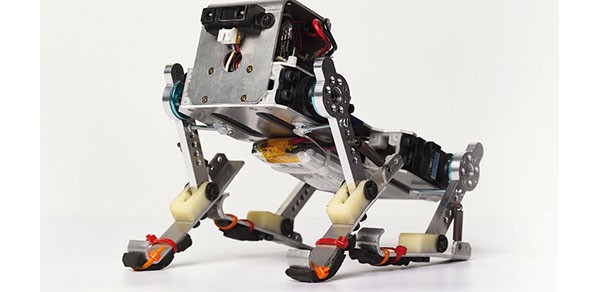
Cambridge researchers are studying the interaction between robots and humans – and teaching them how to do the very difficult things that we find easy.
That last metre is a really interesting problem, because it's the barrier to robots really being able to help humanity.
Dr Fumiya Iida
Stacks of vertical shelves weave around each other in what looks like an intricately choreographed – if admittedly inelegant – ballet. It’s been performed since 2014 in Amazon’s cavernous warehouses as robots carry shelves, each weighing more than 1,000 kg, on their backs. The robots cut down on time and human error, but they still have things to learn.
Once an order is received, a robot goes to the shelf where the ordered item is stored. It picks up the shelf and takes it to an area where the item is removed and placed in a plastic bin, ready for packing and sending to the customer. It may sound counterintuitive, but the most difficult part of this sequence is taking the item from the shelf and putting it in the plastic bin.
For Dr Fumiya Iida, Lecturer in Mechatronics, his is a typical example of what he and other roboticists call a ‘last metre’ problem. “An Amazon order could be anything from a pillow, to a book, to a hat, to a bicycle,” he says. “For a human, it’s generally easy to pick up an item without dropping or crushing it – we instinctively know how much force to use. But this is really difficult for a robot.”
In the 1980s, a group of scientists gave this kind of problem another name – Moravec’s paradox – which essentially states that things that are easy for humans are difficult for robots, and vice versa. “Robots can go all the way to Mars, but they can’t pick up the groceries,” says Dr Iida.
One of the goals of Dr Iida’s lab in the Department of Engineering is to find effective solutions to various kinds of last metre problems. One example is the Amazon ‘Picking Challenge’, an annual competition in which university robotics teams from all over the world attempt to design robots that can deal with the problem of putting a book into a plastic bin. Dr Iida’s team is also working with British Airways, who have a last metre problem with baggage handling: a process that is almost entirely automated, except for the point when suitcases of many different shapes, sizes and weights need to be put onto an aircraft.
And for the past two summers, they’ve been working with fruit and vegetable group G’s Growers to design robots that can harvest lettuces without crushing them.
“That last metre is a really interesting problem,” Dr Iida says. “It’s the front line in robotics because so many things we do in our lives are last metre problems, and that last metre is the barrier to robots really being able to help humanity.”
Although the thought of having a robot to cook dinner or perform other basic daily tasks may sound attractive, such domestic applications are still a way off becoming reality. “Robots are becoming part of our society in the areas where they’re needed most – areas like agriculture, medicine, security and logistics – but they can’t go everywhere instantly,” explains Dr Iida.
If, as Dr Iida says, the robot revolution is already happening, how will we as humans interact with them when they become a more visible part of our everyday lives? And how will they interact with us?
As robots become more common place, in our lives, ethical considerations become more important. In his lab, Dr Iida has a robot ‘inventor’, but if the robot invents something of value, who owns the intellectual property? “At the moment, the law says that it belongs to the human who programmed the robot, but that’s an answer to a legislative question,” says Dr Iida. “The ethical questions are a little murkier.”
“Another interesting question is whether a robot can learn to be ethical,” adds Dr Iida. “That’s very interesting scientifically, because it leads to the nature of consciousness. Robots are going to be a bigger and bigger part of our lives, so we all need to be thinking about these questions.”
This is an edited version of an article that first appeared in the University of Cambridge's Research Horizons magazine, issue 35 and the University of Cambridge website.

